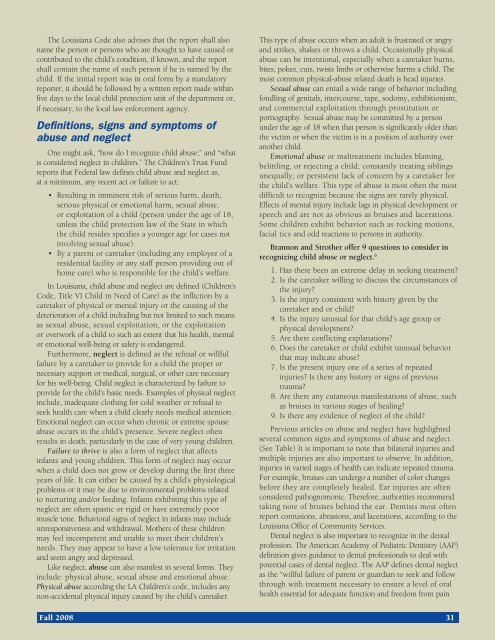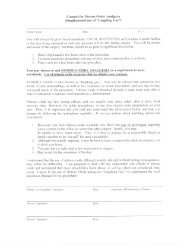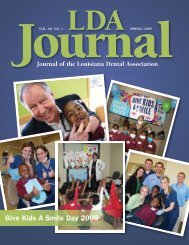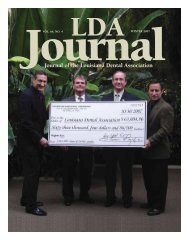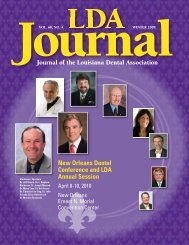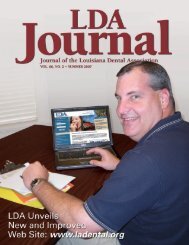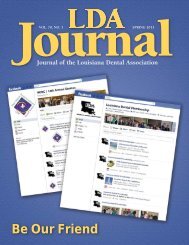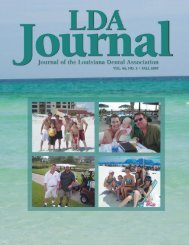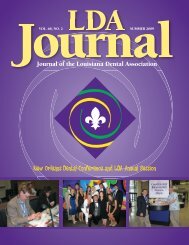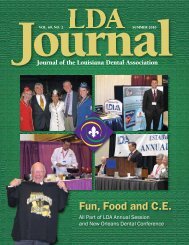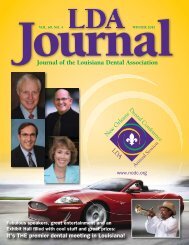Journal of the Louisiana Dental Association
Journal of the Louisiana Dental Association
Journal of the Louisiana Dental Association
- No tags were found...
Create successful ePaper yourself
Turn your PDF publications into a flip-book with our unique Google optimized e-Paper software.
The <strong>Louisiana</strong> Code also advises that <strong>the</strong> report shall alsoname <strong>the</strong> person or persons who are thought to have caused orcontributed to <strong>the</strong> child’s condition, if known, and <strong>the</strong> reportshall contain <strong>the</strong> name <strong>of</strong> such person if he is named by <strong>the</strong>child. If <strong>the</strong> initial report was in oral form by a mandatoryreporter, it should be followed by a written report made withinfive days to <strong>the</strong> local child protection unit <strong>of</strong> <strong>the</strong> department or,if necessary, to <strong>the</strong> local law enforcement agency.Definitions, signs and symptoms <strong>of</strong>abuse and neglectOne might ask, “how do I recognize child abuse;” and “whatis considered neglect in children.” The Children’s Trust Fundreports that Federal law defines child abuse and neglect as,at a minimum, any recent act or failure to act: serious physical or emotional harm, sexual abuse,or exploitation <strong>of</strong> a child (person under <strong>the</strong> age <strong>of</strong> 18,unless <strong>the</strong> child protection law <strong>of</strong> <strong>the</strong> State in which<strong>the</strong> child resides specifies a younger age for cases notinvolving sexual abuse). residential facility or any staff person providing out <strong>of</strong>home care) who is responsible for <strong>the</strong> child’s welfare.In <strong>Louisiana</strong>, child abuse and neglect are defined (Children’sCode, Title VI Child in Need <strong>of</strong> Care) as <strong>the</strong> infliction by acaretaker <strong>of</strong> physical or mental injury or <strong>the</strong> causing <strong>of</strong> <strong>the</strong>deterioration <strong>of</strong> a child including but not limited to such meansas sexual abuse, sexual exploitation, or <strong>the</strong> exploitationor overwork <strong>of</strong> a child to such an extent that his health, mentalor emotional well-being or safety is endangered.Fur<strong>the</strong>rmore, neglect is defined as <strong>the</strong> refusal or willfulfailure by a caretaker to provide for a child <strong>the</strong> proper ornecessary support or medical, surgical, or o<strong>the</strong>r care necessaryfor his well-being. Child neglect is characterized by failure toprovide for <strong>the</strong> child’s basic needs. Examples <strong>of</strong> physical neglectinclude, inadequate clothing for cold wea<strong>the</strong>r or refusal toseek health care when a child clearly needs medical attention.Emotional neglect can occur when chronic or extreme spouseabuse occurs in <strong>the</strong> child’s presence. Severe neglect <strong>of</strong>tenresults in death, particularly in <strong>the</strong> case <strong>of</strong> very young children.Failure to thrive is also a form <strong>of</strong> neglect that affectsinfants and young children. This form <strong>of</strong> neglect may occurwhen a child does not grow or develop during <strong>the</strong> first threeyears <strong>of</strong> life. It can ei<strong>the</strong>r be caused by a child’s physiologicalproblems or it may be due to environmental problems relatedto nurturing and/or feeding. Infants exhibiting this type <strong>of</strong>neglect are <strong>of</strong>ten spastic or rigid or have extremely poormuscle tone. Behavioral signs <strong>of</strong> neglect in infants may includeunresponsiveness and withdrawal. Mo<strong>the</strong>rs <strong>of</strong> <strong>the</strong>se childrenmay feel incompetent and unable to meet <strong>the</strong>ir children’sneeds. They may appear to have a low tolerance for irritationand seem angry and depressed.Like neglect, abuse can also manifest in several forms. Theyinclude: physical abuse, sexual abuse and emotional abuse.Physical abuse according <strong>the</strong> LA Children’s code, includes anynon-accidental physical injury caused by <strong>the</strong> child’s caretaker.This type <strong>of</strong> abuse occurs when an adult is frustrated or angryand strikes, shakes or throws a child. Occasionally physicalabuse can be intentional, especially when a caretaker burns,bites, pokes, cuts, twists limbs or o<strong>the</strong>rwise harms a child. Themost common physical-abuse related death is head injuries.Sexual abuse can entail a wide range <strong>of</strong> behavior includingfondling <strong>of</strong> genitals, intercourse, rape, sodomy, exhibitionism,and commercial exploitation through prostitution orpornography. Sexual abuse may be committed by a personunder <strong>the</strong> age <strong>of</strong> 18 when that person is significantly older than<strong>the</strong> victim or when <strong>the</strong> victim is in a position <strong>of</strong> authority overano<strong>the</strong>r child.Emotional abuse or maltreatment includes blaming,belittling, or rejecting a child; constantly treating siblingsunequally; or persistent lack <strong>of</strong> concern by a caretaker for<strong>the</strong> child’s welfare. This type <strong>of</strong> abuse is most <strong>of</strong>ten <strong>the</strong> mostdifficult to recognize because <strong>the</strong> signs are rarely physical.Effects <strong>of</strong> mental injury include lags in physical development orspeech and are not as obvious as bruises and lacerations.Some children exhibit behavior such as rocking motions,facial tics and odd reactions to persons in authority.Brannon and Stro<strong>the</strong>r <strong>of</strong>fer 9 questions to consider inrecognizing child abuse or neglect. 61. Has <strong>the</strong>re been an extreme delay in seeking treatment?2. Is <strong>the</strong> caretaker willing to discuss <strong>the</strong> circumstances <strong>of</strong><strong>the</strong> injury?3. Is <strong>the</strong> injury consistent with history given by <strong>the</strong>caretaker and or child?4. Is <strong>the</strong> injury unusual for that child’s age group orphysical development?5. Are <strong>the</strong>re conflicting explanations?6. Does <strong>the</strong> caretaker or child exhibit unusual behaviorthat may indicate abuse?7. Is <strong>the</strong> present injury one <strong>of</strong> a series <strong>of</strong> repeatedinjuries? Is <strong>the</strong>re any history or signs <strong>of</strong> previoustrauma?8. Are <strong>the</strong>re any cutaneous manifestations <strong>of</strong> abuse, suchas bruises in various stages <strong>of</strong> healing?9. Is <strong>the</strong>re any evidence <strong>of</strong> neglect <strong>of</strong> <strong>the</strong> child?Previous articles on abuse and neglect have highlightedseveral common signs and symptoms <strong>of</strong> abuse and neglect.(See Table) It is important to note that bilateral injuries andmultiple injuries are also important to observe. In addition,injuries in varied stages <strong>of</strong> health can indicate repeated trauma.For example, bruises can undergo a number <strong>of</strong> color changesbefore <strong>the</strong>y are completely healed. Ear injuries are <strong>of</strong>tenconsidered pathognomonic. Therefore, authorities recommendtaking note <strong>of</strong> bruises behind <strong>the</strong> ear. Dentists most <strong>of</strong>tenreport contusions, abrasions, and lacerations, according to <strong>the</strong><strong>Louisiana</strong> Office <strong>of</strong> Community Services.<strong>Dental</strong> neglect is also important to recognize in <strong>the</strong> dentalpr<strong>of</strong>ession. The American Academy <strong>of</strong> Pediatric Dentistry (AAP)definition gives guidance to dental pr<strong>of</strong>essionals to deal withpotential cases <strong>of</strong> dental neglect. The AAP defines dental neglectas <strong>the</strong> “willful failure <strong>of</strong> parent or guardian to seek and followthrough with treatment necessary to ensure a level <strong>of</strong> oralhealth essential for adequate function and freedom from painFall 2008 31


